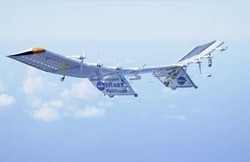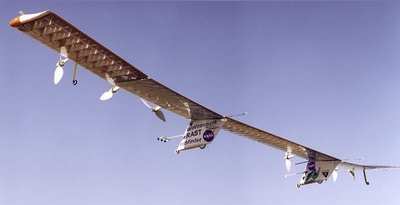Fri, Jun 27, 2003
Breaks Up Over The Pacific At 8000 Feet
 An extraordinary NASA research
project has had a serious accident. The remotely operated Helios
Prototype aircraft, a proof-of-concept solar-electric flying wing
designed to operate at extremely high altitudes for long duration,
was destroyed when it crashed Thursday during a checkout flight
from the Navy’s Pacific Missile Range Facility (PMRF) on the
Hawaiian island of Kauai.
An extraordinary NASA research
project has had a serious accident. The remotely operated Helios
Prototype aircraft, a proof-of-concept solar-electric flying wing
designed to operate at extremely high altitudes for long duration,
was destroyed when it crashed Thursday during a checkout flight
from the Navy’s Pacific Missile Range Facility (PMRF) on the
Hawaiian island of Kauai.
There was no property damage or injuries on the ground resulting
from the accident. The remotely piloted aircraft came down within
the confines of the PMRF test range over the Pacific Ocean west of
the facility. The cause of the mishap is not yet known.
The solar-electric, propeller-driven aircraft had been flying
under the guidance of ground-based mission controllers for
AeroVironment, Inc., of Monrovia, Calif., the plane’s builder
and operator. The lightweight flying wing had taken off from PMRF
at about 10:06 a.m. on a functional checkout flight and had been
aloft for about 29 minutes over the PMRF test range when the mishap
occurred. The mishap occurred during a shakedown mission in
preparation for a long-endurance mission of almost two days that
had been planned for next month.
The Helios Prototype is one of several remotely piloted aircraft
whose technological development has been sponsored and funded by
NASA under the Environmental Research Aircraft and Sensor
Technology (ERAST) program, managed by NASA’s Dryden Flight
Research Center, Edwards, Calif. Current to power its electric
motors and other systems was generated by high-efficiency solar
cells spread across the upper surface of its 247-foot long wing
during the day and by an experimental fuel cell-based electrical
system at night. The Helios Prototype was designed to fly at
altitudes of up to 100,000 feet on single-day atmospheric science
and imaging missions, as well as perform multi-day
telecommunications relay missions at altitudes of 50,000 to 65,000
feet.

The Helios Prototype set a world altitude record for winged
aircraft of 96,863 feet during a flight from the Navy facility at
Barking Sands, Kauai, in August 2001.
An accident investigation team will be formed by NASA and
supported by AeroVironment and the U.S. Navy to determine the exact
cause of the Helios Prototype mishap.
More News
“These new aircraft strengthen our ability to respond quickly, train effectively and support communities nationwide. Textron Aviation has been a steadfast supporter in helpin>[...]
From 2011 (YouTube Edition): Rugged, Legendary, STOL Twin Makes A Comeback The de Havilland Twin Otter is an airplane with a long history, and it gained a reputation as a workhorse>[...]
A Wind Gust Lifted The Right Wing And The Airplane Turned To The Left Analysis: The pilot was departing from a 2,395-ft-long by 50-ft-wide turf runway. The pilot reported that afte>[...]
Have A Story That NEEDS To Be Featured On Aero-News? Here’s How To Submit A Story To Our Team Some of the greatest new stories ANN has ever covered have been submitted by our>[...]
Braking Action Advisories When tower controllers receive runway braking action reports which include the terms “medium," “poor," or “nil," or whenever weather con>[...]
 Aero-News: Quote of the Day (12.18.25)
Aero-News: Quote of the Day (12.18.25) Classic Aero-TV: Viking Twin Otter 400--Bringing the DHC-6 Back Into Production
Classic Aero-TV: Viking Twin Otter 400--Bringing the DHC-6 Back Into Production NTSB Final Report: Rans Employee Flying Club Rans S-6ES Coyote II
NTSB Final Report: Rans Employee Flying Club Rans S-6ES Coyote II ANN FAQ: Submit a News Story!
ANN FAQ: Submit a News Story! ANN's Daily Aero-Term (12.18.25): Braking Action Advisories
ANN's Daily Aero-Term (12.18.25): Braking Action Advisories




